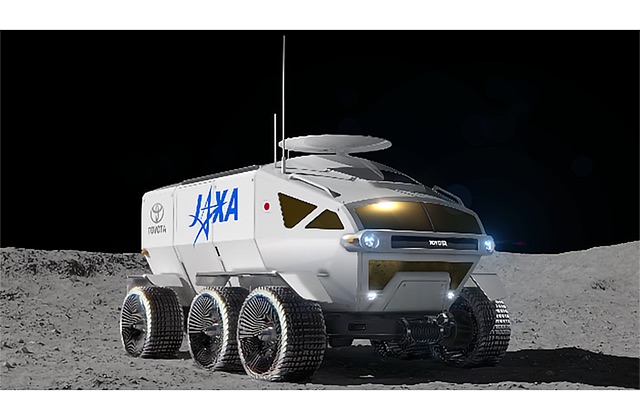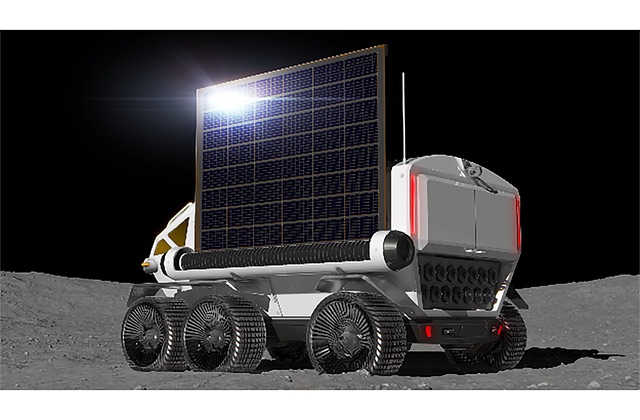Japan Taps Toyota to Build Futuristic Moon Rover

Japan wants to build the ultimate moon rover for astronauts and has tapped Toyota to help develop a futuristic, off-road, lunar vehicle that could potentially launch in 2029.
The Japan Aerospace Exploration Agency announced Tuesday (March 12) that it is working with vehicle manufacturer Toyota to develop the moon rover of the future – a massive vehicle powered by fuel cells with a maximum range of a whopping 6,213 miles (10,000 kilometers).
“Manned rovers with pressurized cabins are an element that will play an important role in full-fledged exploration and use of the lunar surface," JAXA President Hiroshi Yamakawa said in a statement. "Through our joint studies going forward, we would like to put to use Toyota’s excellent technological abilities related to mobility, and we look forward to the acceleration of our technological studies for the realization of a manned, pressurized rover."
Related: Moon Driving: NASA's Apollo Lunar Rovers in Photos
The plan, JAXA officials said, is to work with Toyota on a huge, pressurized rover that will be typically crewed by two astronauts but capable of accommodating up to four people in an emergency. If current concept designs hold true, the rover will be huge — at least 20 feet (6 meters) long, have six wheels, and measure 17 feet (5.2 m) wide and 12.4 feet (3.8 m) high. The vehicle will have about 140 square feet (13 square meters) of living space, JAXA officials said.
Two concept images of the JAXA-Toyota moon rover show a sleek, futuristic lunar car with a cockpit like a nose covered in angular windows. The concept design shows that the rover has headlights and running lights (they might be signal blinkers), as well as brake lights. One image shows what appears to be a rollout solar array to generate power.

In comparison, NASA's unpressurized lunar rovers used on the Apollo missions decades ago could seat two astronauts (wearing spacesuits) and were powered by batteries. These vehicles had four wheels and were 10.1 feet long (3.1 m) and 7.5 feet wide (2.3 m), with a maximum height of 3.7 feet (1.14 m). The Lunar Roving Vehicles, as NASA called them, were powered by batteries, according to NASA documents.
Get the Space.com Newsletter
Breaking space news, the latest updates on rocket launches, skywatching events and more!
Related: NASA's Space Exploration Vehicle Concept in Pictures
JAXA and Toyota have been working together on the moon rover project since May 2018. Building the equivalent of a rugged sports utility vehicle for the moon comes with challenges, JAXA officials said.
"Lunar gravity is one-sixth of that on Earth. Meanwhile, the moon has a complex terrain with craters, cliffs, and hills," astronaut Koichi Wakata, JAXA's vice president, said in the statement. "Moreover, it is exposed to radiation and temperature conditions that are much harsher than those on Earth, as well as an ultra-high vacuum environment."
For its part, Toyota said the company is excited to develop JAXA's moon rover, and stressed that the vehicle's safety will be vital for astronauts.
"Furthermore, cars are used in all of Earth’s regions, and, in some regions, cars play active roles as partners for making sure that people come back alive," Toyota President Akio Toyoda said in the statement. "And I think that coming back alive is exactly what is needed in this project."
JAXA's moon rover projects comes as NASA is developing its own plans to return astronauts to the moon, first with a lunar orbiting "gateway" space station. That would be followed by crewed lunar landings in 2026.
NASA chief Jim Bridenstine has repeatedly stressed that the U.S. agency's return to the moon will occur in cooperation with international partners. JAXA officials did not specifically say that the Toyota moon rover project will be part of its contribution to a future human moon mission effort, the agency did say in a joint statement with partners that it is committed to participating in NASA's lunar plans.
- In Photos: China's Chang'e 4 Moon Rover Toys
- The Evolution of NASA's Mars Rover Tires in Pictures
- Google Lunar X Prize: Hakuto's Tethered Moon Rovers (Gallery)
Email Tariq Malik at tmalik@space.com or follow him @tariqjmalik. Follow us @Spacedotcom and Facebook.
Join our Space Forums to keep talking space on the latest missions, night sky and more! And if you have a news tip, correction or comment, let us know at: community@space.com.

Tariq is the Editor-in-Chief of Space.com and joined the team in 2001, first as an intern and staff writer, and later as an editor. He covers human spaceflight, exploration and space science, as well as skywatching and entertainment. He became Space.com's Managing Editor in 2009 and Editor-in-Chief in 2019. Before joining Space.com, Tariq was a staff reporter for The Los Angeles Times covering education and city beats in La Habra, Fullerton and Huntington Beach. In October 2022, Tariq received the Harry Kolcum Award for excellence in space reporting from the National Space Club Florida Committee. He is also an Eagle Scout (yes, he has the Space Exploration merit badge) and went to Space Camp four times as a kid and a fifth time as an adult. He has journalism degrees from the University of Southern California and New York University. You can find Tariq at Space.com and as the co-host to the This Week In Space podcast with space historian Rod Pyle on the TWiT network. To see his latest project, you can follow Tariq on Twitter @tariqjmalik.









